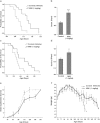Recent advances in amyotrophic lateral sclerosis research: perspectives for personalized clinical application
- PMID: 23199069
- PMCID: PMC3405320
- DOI: 10.1007/s13167-010-0026-1
Recent advances in amyotrophic lateral sclerosis research: perspectives for personalized clinical application
Abstract
Treatment of amyotrophic lateral sclerosis (ALS) has been fueled, in part, by frustration over the shortcomings of the symptomatic drugs available, since these do not impede the progression of this disease. Currently, over 150 different potential therapeutic agents or strategies have been tested in preclinical models of ALS. Unfortunately, therapeutic modifiers of murine ALS have failed to be successfully translated into strategies for patients, probably because of differences in pharmacokinetics of the therapeutic agents, route of delivery, inefficiency of the agents to affect the distinct pathologies of the disease or inherent limitations of the available animal models. Given the multiplicity of the pathological mechanisms implicated in ALS, new therapies should consider the simultaneous manipulation of multiple targets. Additionally, a better management of ALS therapy should include understanding the interactions between potential risk factors, biomarkers and heterogeneous clinical features of the patients, aiming to manage their adverse events or personalize the safety profile of these agents. This review will discuss novel pharmacological approaches concerning adjusted therapy for ALS patients: iron-binding brain permeable multimodal compounds, genetic manipulation and cell-based treatment.
Figures





Similar articles
-
Oxidative Stress in Amyotrophic Lateral Sclerosis: Pathophysiology and Opportunities for Pharmacological Intervention.Oxid Med Cell Longev. 2020 Nov 15;2020:5021694. doi: 10.1155/2020/5021694. eCollection 2020. Oxid Med Cell Longev. 2020. PMID: 33274002 Free PMC article. Review.
-
Overview of Lipid Biomarkers in Amyotrophic Lateral Sclerosis (ALS).Adv Exp Med Biol. 2019;1161:233-241. doi: 10.1007/978-3-030-21735-8_18. Adv Exp Med Biol. 2019. PMID: 31562633 Review.
-
A retrospective review of the progress in amyotrophic lateral sclerosis drug discovery over the last decade and a look at the latest strategies.Expert Opin Drug Discov. 2015 Oct;10(10):1099-118. doi: 10.1517/17460441.2015.1067197. Epub 2015 Aug 26. Expert Opin Drug Discov. 2015. PMID: 26307158 Review.
-
Biomarkers and future targets for development in amyotrophic lateral sclerosis.Curr Med Chem. 2014;21(31):3535-50. doi: 10.2174/0929867321666140601161148. Curr Med Chem. 2014. PMID: 24934359 Review.
-
Advances in disease-modifying pharmacotherapies for the treatment of amyotrophic lateral sclerosis.Expert Opin Pharmacother. 2020 Jun;21(9):1103-1110. doi: 10.1080/14656566.2020.1746270. Epub 2020 Apr 3. Expert Opin Pharmacother. 2020. PMID: 32242755 Review.
Cited by
-
Amyotrophic lateral sclerosis: a focus on disease progression.Biomed Res Int. 2014;2014:925101. doi: 10.1155/2014/925101. Epub 2014 Aug 3. Biomed Res Int. 2014. PMID: 25157374 Free PMC article. Review.
-
Additive Neuroprotective Effects of the Multifunctional Iron Chelator M30 with Enriched Diet in a Mouse Model of Amyotrophic Lateral Sclerosis.Neurotox Res. 2016 Feb;29(2):208-17. doi: 10.1007/s12640-015-9574-4. Epub 2015 Nov 18. Neurotox Res. 2016. PMID: 26581376
-
Multi-Target Directed Donepezil-Like Ligands for Alzheimer's Disease.Front Neurosci. 2016 May 25;10:205. doi: 10.3389/fnins.2016.00205. eCollection 2016. Front Neurosci. 2016. PMID: 27252617 Free PMC article. Review.
-
Nuclear poly(ADP-ribose) activity is a therapeutic target in amyotrophic lateral sclerosis.Acta Neuropathol Commun. 2018 Aug 29;6(1):84. doi: 10.1186/s40478-018-0586-1. Acta Neuropathol Commun. 2018. PMID: 30157956 Free PMC article.
-
Mesenchymal stem cell therapy in amyotrophic lateral sclerosis (ALS) patients: A comprehensive review of disease information and future perspectives.Iran J Basic Med Sci. 2023;26(8):872-881. doi: 10.22038/IJBMS.2023.66364.14572. Iran J Basic Med Sci. 2023. PMID: 37427325 Free PMC article. Review.
References
-
- Cronin S, Berger S, Ding J, Schymick JC, Washecka N, Hernandez DG, Greenway MJ, Bradley DG, Traynor BJ, Hardiman O. A genome-wide association study of sporadic ALS in a homogenous Irish population. Hum Mol Genet. 2008;17:768–74. - PubMed
-
- Gonzalez de Aguilar JL, Echaniz-Laguna A, Fergani A, Rene F, Meininger V, Loeffler JP, Dupuis L. Amyotrophic lateral sclerosis: all roads lead to Rome. J Neurochem. 2007;101:1153–60. - PubMed
-
- Santillo AF, Skoglund L, Lindau M, Eeg-Olofsson KE, Tovi M, Engler H, Brundin RM, Ingvast S, Lannfelt L, Glaser A, Kilander L. Frontotemporal dementia-amyotrophic lateral sclerosis complex is simulated by neurodegeneration with brain iron accumulation. Alzheimer Dis Assoc Disord. 2009;23:298–300. - PubMed
-
- Cozzolino M, Ferri A, Carri MT. Amyotrophic lateral sclerosis: from current developments in the laboratory to clinical implications. Antioxid Redox Signal. 2008;10:405–43. - PubMed
LinkOut - more resources
Full Text Sources
Miscellaneous

